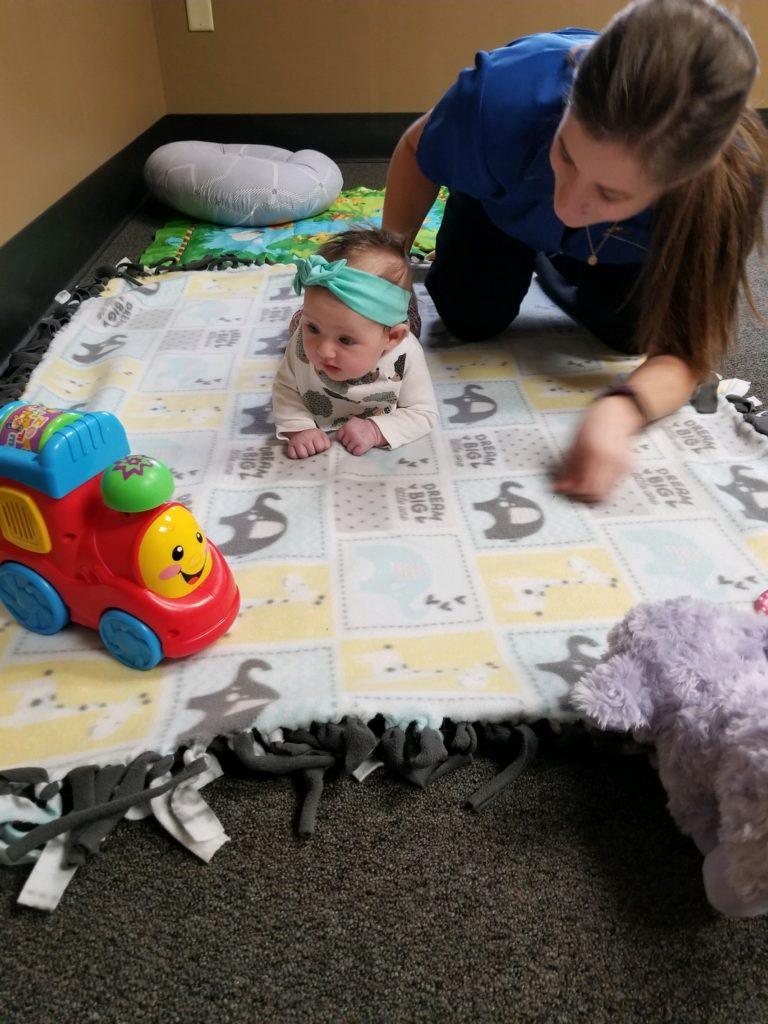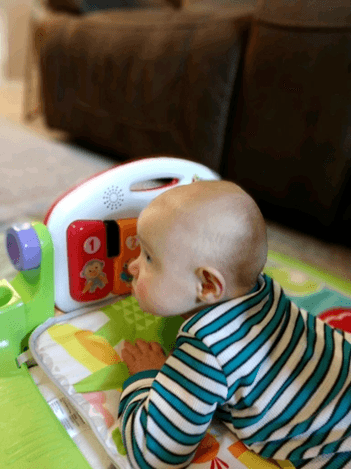Tummy Time
Serving Cincinnati, Dayton and surrounding areas
Why is Tummy Time Important?
Today parents are offered so many options for positioning for their babies. You can place your baby in a swing, in a bouncy seat, in a stroller, in a car seat, in a Bumbo seat, in a Johnny jump up and in a high chair.
Actually, the best place for your baby when not in your arms is on the floor. This gives your child the opportunity to explore their new world. Place you child on their back under a baby gym so they can reach and play. This will help your baby to discover their hands and improve eye hand coordination.
Now, play on the tummy. This is very important. Why?

Developmental Checklist
Is your child meeting their developmental milestones?
Lying on the belly requires that an infant be able to lift his/her head (this is called extension of the neck) progressing to propping on forearms (more extension now involving the upper half of the back) followed by propping on straight arms (even more extension of the back).
 Tummy time gives the child a different visual field to look at and explore. The strength and endurance required to maintain your position on your belly as well as to weight shift to lift an arm and move is very difficult. Babies often resist this position for an easier position of flexion – lying on their back or snuggling on their parent’s chest.The head/neck control a baby gains while playing on their tummy allows them to have more success with being held upright as well as gaining the skill of sitting.
Tummy time gives the child a different visual field to look at and explore. The strength and endurance required to maintain your position on your belly as well as to weight shift to lift an arm and move is very difficult. Babies often resist this position for an easier position of flexion – lying on their back or snuggling on their parent’s chest.The head/neck control a baby gains while playing on their tummy allows them to have more success with being held upright as well as gaining the skill of sitting.
Strength in the trunk (the back and belly) helps a child progress to sitting on their own. A balance is needed between the belly, neck and back muscles (flexion and extension) as well as arm strength in order to have success with sitting. When a child first begins to sit, he/she will prop on straight arms. This arm strength was gained during tummy time propping on first bent then straight arms.
 Fun tip: Try this yourself! Lie on your belly and prop on your forearms and then on straight arms. Feel how hard it is to prop on straight arms. Now you can understand why your child might resist this position. Also, you can understand how much strength arms can develop in this position.
Fun tip: Try this yourself! Lie on your belly and prop on your forearms and then on straight arms. Feel how hard it is to prop on straight arms. Now you can understand why your child might resist this position. Also, you can understand how much strength arms can develop in this position.
Another fun tip: First lie flat on your belly with you arms flat at your sides. Lift your head and look around you. Now prop on your forearms and look around. Finally, prop on extended arms and look around. Notice how your visual field (what you see) changes. This is important for a child to expand what they see as well as to mature their vestibular system (the ability of the senses within your head to adjust to changes in position).
Developmentally, a child progresses from sitting propped on straight arms to weight shifting and reach with each arm to play. This weight shift and reach was first learned while on their tummy.
Ultimately, a child will begin to sit with hands free. This means the child has achieved a balance of strength and endurance of the muscles in their neck, back and belly (their trunk) allowing the child to maintain an upright sitting position for functional play. Continue to challenge your child’s development by seeking out the knowledge on how to push their progress to each next step.
Look What I Can Do!
At 0-3 months old, I will be able to start holding my head up when placed on my tummy. At first, I will be looking straight down, but with practice, I will be able to lift it even higher. Make sure my arms are under me so I learn to push up.
At 3-6 months old, I will be able to push up more through my arms so I can really look around. I will be able to reach for toys and bring them to my mouth. Make sure I have plenty of toys!
At 6-9 months old I will start to move around while on my tummy. I will pivot and I may learn to move backwards before I am strong enough to move forward. I love to explore!
 At 9-12 months old I will be strong enough to push up onto my hands and knees for crawling. Watch out, world! Here I come!
At 9-12 months old I will be strong enough to push up onto my hands and knees for crawling. Watch out, world! Here I come!
Tummy time should always be supervised and done when your child is awake.
Tummy time should be done when your baby is happy – not tired or hungry.
Tummy time should not be done right after your baby has eaten. This can put pressure on a full tummy and cause your baby to spit up.
Perform tummy time for short intervals (10 minutes), several times per day.
Use a nursing pillow or small towel roll under the arms. This takes some of the weight off of the arms, making it easier to lift his head.
Use toys and music to make it fun.
Get on the floor so your baby can look at you.
Hold your baby on your chest, facing you, and recline back so you are face to face. Babies loves to hear your voice and see your face!
When and How Much?
Tummy time is needed every day and should begin the first day you bring your infant home from the hospital. Start with just a few minutes at a time, several times per day. Gradually build up, as your baby is able to tolerate more.

Why tummy time?
Tummy time helps your baby get stronger in order to develop his skills.
Tummy time is needed to promote motor skills such as sitting up and crawling.
It strengthens the hands for holding onto toys or a bottle and helps to develop vision.
Babies who do not spend time on their tummy are more likely to have delays in their motor skills.
What if my baby doesn’t like it?
Hang in there and keep trying! With practice and toys to make it fun, your child will learn to enjoy it.
Keep that perfectly shaped head
Babies who are placed too much in swings, car seats and on their backs and not enough on their tummy can end up having a misshapen head.
Putting your baby on his tummy several times throughout the day keeps pressure off of the back of the head and keeps that perfectly round little head.
Avoid having your baby sleep in a swing or car seat, if you can. Babies should be placed on their backs to sleep on a flat surface. The flat surface allows your baby to turn his head to either side, helping to form the perfect head shape.
Tummy time should be fun and provide learning opportunities.
Remember to place your child on their back to sleep.
Container Baby Syndrome and Promoting Tummy Time
What is container baby syndrome?
Container baby syndrome occurs when an infant spends increased time in various containers during the day. A container can be anything from high chairs, jumpers/walkers, infant swings, and even car seats. Using containers for prolonged periods of time prevent proper posture and alignment which leads to decreased muscle use.
When an infant has decreased use of their muscles, their development in skills such as sitting, standing, and walking can be delayed. Other potential issues from increased container use are delays in gross motor milestones, development of flat spots on the child’s head, and torticollis (tightening of neck musculature).


Is it ever ok to put an infant in a container?
Containers are meant to be used sparingly (a few minutes every day) when a caregiver is not able to give full attention to their child. Such instances include cooking, bathing, and housework.
Suggested positions for child during the day
For proper development, it is recommended when a child is awake, they should be participating in tummy time as much as they will tolerate. During sleep hours, leaving a child alone in their crib and on their back is recommended (prevent from sleeping in their car seat).
How to make tummy time more enjoyable for caregiver and child
Tummy time is an optimal position for infant development. Working tummy time into the child’s routine as early as possible will improve their tolerance for tummy time as they get older. While lying on their stomachs, infants work on head, neck, and upper body strength as well as building coordination in attempts to reach for toys. The following list are a few ways to make tummy time enjoyable for the caregiver and child.
- Place a rolled towel under the child’s chest, placing arms on top of the towel - be sure their chin is in front of the towel so the airway does not get blocked
- Put your face at the level of the child and interact with them
- Place a mirror in front of them so they can use their neck muscles to lift their head up to look at themselves
- Put the infant on the caregiver’s chest to improve tolerance of the position and to introduce the position to a newborn
- Side lying is a good alternative to the tummy position to get the infant off their back. Placing a rolled towel on their back can give them more security in this new position
 Skip to content
Skip to content





